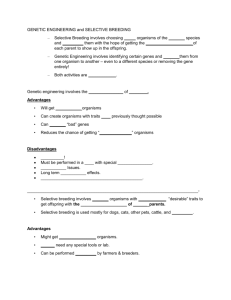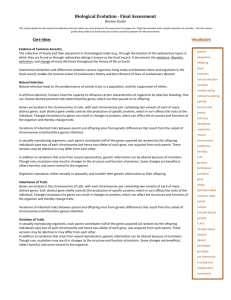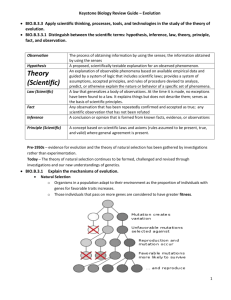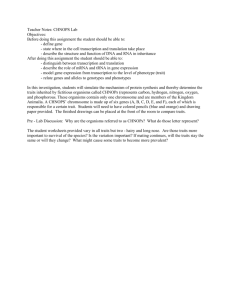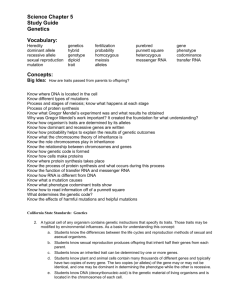evolution - Alvin ISD
advertisement
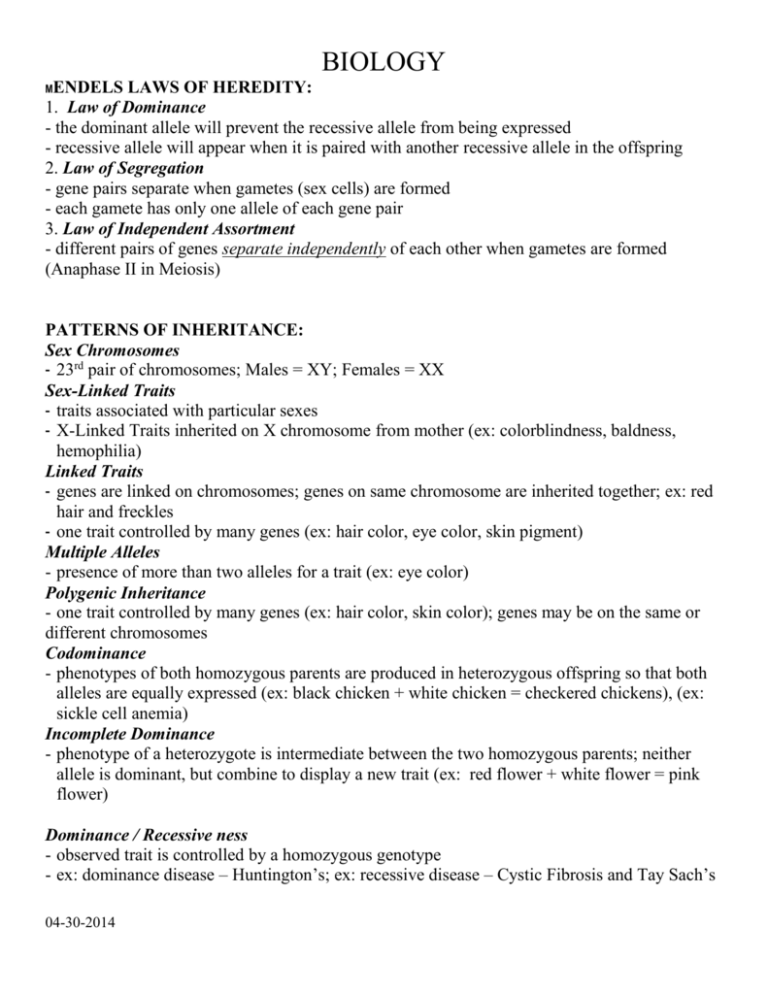
BIOLOGY MENDELS LAWS OF HEREDITY: 1. Law of Dominance - the dominant allele will prevent the recessive allele from being expressed - recessive allele will appear when it is paired with another recessive allele in the offspring 2. Law of Segregation - gene pairs separate when gametes (sex cells) are formed - each gamete has only one allele of each gene pair 3. Law of Independent Assortment - different pairs of genes separate independently of each other when gametes are formed (Anaphase II in Meiosis) PATTERNS OF INHERITANCE: Sex Chromosomes - 23rd pair of chromosomes; Males = XY; Females = XX Sex-Linked Traits - traits associated with particular sexes - X-Linked Traits inherited on X chromosome from mother (ex: colorblindness, baldness, hemophilia) Linked Traits - genes are linked on chromosomes; genes on same chromosome are inherited together; ex: red hair and freckles - one trait controlled by many genes (ex: hair color, eye color, skin pigment) Multiple Alleles - presence of more than two alleles for a trait (ex: eye color) Polygenic Inheritance - one trait controlled by many genes (ex: hair color, skin color); genes may be on the same or different chromosomes Codominance - phenotypes of both homozygous parents are produced in heterozygous offspring so that both alleles are equally expressed (ex: black chicken + white chicken = checkered chickens), (ex: sickle cell anemia) Incomplete Dominance - phenotype of a heterozygote is intermediate between the two homozygous parents; neither allele is dominant, but combine to display a new trait (ex: red flower + white flower = pink flower) Dominance / Recessive ness - observed trait is controlled by a homozygous genotype - ex: dominance disease – Huntington’s; ex: recessive disease – Cystic Fibrosis and Tay Sach’s 04-30-2014 BIOLOGY SOURCES OF VARIATION: Crossing Over - genes from one chromosome are exchanged with genes from another chromosome - occurs regularly during meiosis and leads to greater genetic variation - many different phenotypes are a result of the random assortment of genes that occurs during sexual reproduction Nondisjunction - during meiosis, homologous pairs of chromosomes don’t separate - results in half the sex cells having an extra chromosome and the other half having one less chromosome - if fertilization occurs with an abnormal sex cell, zygote formed will have either one extra (trisomy) or one less (monosomy) than the diploid number (ex: Down’s Syndrome caused by extra 21st chromosome) Genetic Variation - influenced by crossing over, mutations, genetic engineering, random assortment of genes, natural selection - genetic variation controlled by sexual reproduction (does not occur in asexual reproduction) - gene regulation vs. gene expression – the expression of genes is regulated by turning genes on / off or amount of action - environment can influence magnitude of gene expression (ex: improper nutrition can prevent proper bone growth) LAWS OF PROBABILITY TO PREDICT INHERITANCE: - Punnett Squares provide a shorthand way of finding expected proportions of possible genotypes and phenotypes in the offspring of a cross. - Fertilization must occur at random - Results are expected, not actual; results based on chance - Results predicted by probability are more likely to be seen when there is a large number of offspring - a monohybrid cross contains four boxes; a cross between two heterozygous individuals would reveal a 1:2:1 genotype ration and a 3:1 phenotype ratio in the offspring; the probability that the offspring will show a dominant phenotype is ¾, or 75% - a dihybrid cross contains sixteen boxes; a dihybrid cross reveals two traits for both parents; a cross between two heterozygous individuals would reveal a 9:3:3:1 phenotype ratio in the offspring 04-30-2014 BIOLOGY KARYOTYPE GENETIC ENGINEERING (GENOMICS): - sometimes called biotechnology - process of transferring a gene (DNA) from one organism to another - Organisms with transferred gene now produce “recombined” genetic code ( called “recombinant DNA”) - Ex: insulin produced through bacteria - Ex: oil-eating bacteria - Has application in medicine, environment, industry, agriculture, selective breeding - Human Genome Project - DNA Fingerprinting ORIGINS OF LIFE: Biogenesis – idea that living organisms came only from other living organisms Spontaneous Generation – mistaken idea that life can arise from nonliving materials; sometimes called Abiogenesis - Francesco Redi performed controlled experiments that tested spontaneous generation of maggots from decaying meat – disproved idea. - Louis Pasteur performed controlled experiments that tested spontaneous generation of microorganisms in nutrient broth – disproved idea. Protocells – large, ordered structure, enclosed by a membrane, that carries out some life activities, such as growth and division; name given to first living cells, possibly photosynthetic prokaryotes; may have arisen through organic evolution; eukaryotes may have arisen through endosymbiosis (symbiotic relationship between prokaryotes) NATURAL SELECTION and THEORY OF EVOLUTION: - proposed by Charles Darwin - process by which organisms that are best suited to environment survive and pass genetic traits on to offspring - has no effect on increased production of offspring, fossil formation, or changes in habitat - adaptation – organisms with the most suited traits will survive - evolution – change in a species over time (not a single individual, but the group) - microevolution – evolution that occurs within the species level; results from genetic variation and natural selection within a population - antibiotic resistance - pesticide resistance 04-30-2014 BIOLOGY - macroevolution – evolution that occurs between different species; focuses on how groups of organisms change - convergent evolution – two species evolve similarly - divergent evolution – a group of species evolve differently - adaptive radiation – a group of species adapt separately to environments - speciation – formation of a new species - geographic isolation – physical barrier divides a population, results in individuals that cannot mate, leads to a new species - reproductive isolation – genetic mutation or behavioral change prevent mating PUNNETT SQUARE NATURAL SELECTION and THEORY OF EVOLUTION: - proposed by Charles Darwin - process by which organisms that are best suited to environment survive and pass genetic traits on to offspring - has no effect on increased production of offspring, fossil formation, or changes in habitat - adaptation – organisms with the most suited traits will survive - evolution – change in a species over time (not a single individual, but the group) - microevolution – evolution that occurs within the species level; results from genetic variation and natural selection within a population - antibiotic resistance - pesticide resistance - macroevolution – evolution that occurs between different species; focuses on how groups of organisms change - convergent evolution – two species evolve similarly - divergent evolution – a group of species evolve differently - adaptive radiation – a group of species adapt separately to environments - speciation – formation of a new species - geographic isolation – physical barrier divides a population, results in individuals that cannot mate, leads to a new species - reproductive isolation – genetic mutation or behavioral change prevent mating 04-30-2014 BIOLOGY CLASSIFICATION: - process in understanding how organisms are related and how they are different - taxonomy – branch of biology that studies grouping and naming of organisms - history of classification systems - 4th Century B.C., Aristotle proposed two groups (plants and animals) and used common names for identification, based on “blood” and “bloodless” - early 1700s, Carolus Linnaeus developed a system based on physical characteristics - two kingdoms (plants and animals) - developed “genus” and “species” - designed system of naming called binomial nomenclature (“two names”) which gave each organism two names, a genus and a species, Genus always capitalized, both should be underlined or italicized - Six kingdoms: Archaebacteria, Eubacteria), Protista, Fungi, Plantae, and Animalia - a dichotomous key is a tool used to identify organisms by using pairs of contrasting characteristics - basis of current classification: phylogeny, DNA / biochemical analysis, embryology, morphology, Phylogenetic trees LEVELS OF CLASSIFICATION: - Kingdom - Phylum - Class - Order - Family - Genus - Species - COMPARISON OF EUKARYOTE TO PROKARYOTE: - Prokaryote – has nuclear material in the center of the cell, but is not enclosed by a nuclear membrane; no membrane bound organelles; examples: bacteria and blue-green algae - Eukaryote – contain a clearly defined nucleus enclosed by a nuclear membrane and membrane bound organelles; examples: plants, animals, fungi, and protists 04-30-2014 BIOLOGY Three Domain System “The modern system, the Three Domain System, groups organisms primarily based on differences in ribosomal RNA structure. Ribosomal RNA is a molecular building block for ribosomes.” Archaea Eubacteria Eukarya Archaebacter Eubacteria Protista Fungi Plantae Animalia ia Kingdom Kingdom Kingdom Kingdom Kingdom Kingdom ancient true bacteria bacteria Cell wall Cell wall of Protists Eukaryote Eukaryote Eukaryote without peptidoglycan Eukaryote Multicelluar Multicellular Multicellula peptidoglycan Bacteria Unicellular Aerobic Aerobic r Live in Prokaryote Multicellula Decomposer Producer Aerobic environments Unicellular, r Lack Photosynthesis Consumer without oxygen colonial Aerobic chlorophyll Cell wall Cellular Prokaryotic Aerobic / Need Water Pathogenic (cellulose) respiration Unicellular anaerobic Pathogenic Saprophytic / Vascular system, Invertebrat Reproduce Decomposer / parasitic parasitic seeds es Asexually Heterotrophic Animal-like Medicinal, Poisonous Vertebrates Photosynthetic (protozoa) food source Medicinal, food Symmetry (some) Plant-like Heterotrophi source Chemosyntheti (algae) c Alternation of Ex: Homo c (some) Medicinal, Sexual / generations sapiens Pathogenic food source asexual Roots, stems, Medicinal Mobile Alternation leaves Classified by Ex: amoeba of Pollination(fertiliz shape generations ation) Binary fission Often Germination Vaccines, symbiotic Ex: oak antibiotics with algae Ex: Ex: streptococcus mushroom Reward time Evolution of the mind’s big bang http://www.youtubedocumentaries.com/documentary.cfm?name=EVOLUTION_THE_MIND_S_BIG_BANG 04-30-2014
